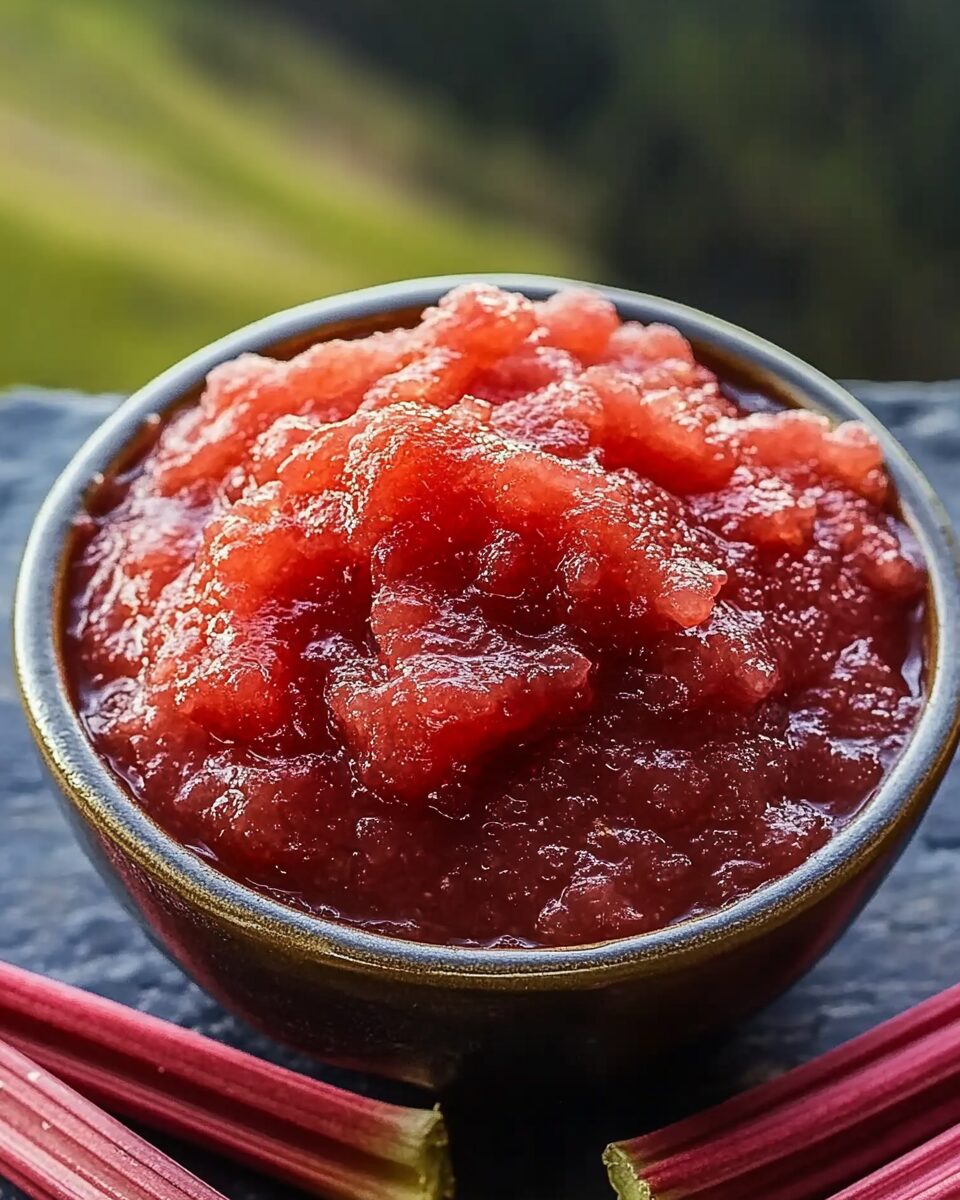The vibrant tang of rhubarb shines in this homemade Rhubarb Butter, slowly simmered with warm spices and a hint of citrus. This delightfully spreadable treat is perfect for transforming your breakfasts, desserts, or tea-time snacks into something truly special. Whether swirled into yogurt, slathered on toast, or used as a filling for pastries, Rhubarb Butter brings an irresistible balance of tart and sweet. It’s a small-batch marvel that captures the essence of spring and early summer in every spoonful. This is not just a condiment it’s a celebration of homemade goodness.
Full Recipe:
Ingredients:
-
6 cups chopped fresh rhubarb (about 1 ½ lbs)
-
1 cup granulated sugar
-
1/4 cup water
-
1 tsp lemon zest
-
1 tbsp lemon juice
-
1/2 tsp ground cinnamon
-
1/4 tsp ground ginger
-
1/8 tsp ground cloves
-
Pinch of salt
Directions:
-
In a large saucepan over medium heat, combine the rhubarb, sugar, and water.
-
Stir gently until the sugar dissolves and the mixture begins to simmer.
-
Reduce heat to low, cover partially, and cook for 15–20 minutes, stirring occasionally, until the rhubarb breaks down and becomes soft.
-
Using an immersion blender or transferring to a standard blender in batches, blend the mixture until smooth.
-
Return the purée to the saucepan, stir in lemon zest, lemon juice, cinnamon, ginger, cloves, and a pinch of salt.
-
Simmer uncovered on low heat, stirring frequently to avoid scorching, for about 30–40 minutes or until thickened to a butter-like consistency.
-
Let it cool completely, then transfer to sterilized jars. Store in the refrigerator for up to 2 weeks or freeze for longer storage.
Prep Time: 10 minutes | Cooking Time: 50 minutes | Total Time: 1 hour
Kcal: 38 kcal per serving | Servings: 32 (1 tbsp servings)
The Sweet Simplicity of Rhubarb Butter: A Nostalgic Homemade Treasure
There’s something deeply comforting about the sound of a bubbling pot on the stove, the scent of simmering fruit wafting through your kitchen, and the anticipation of spooning a lovingly-made spread into warm, waiting jars. Among the world of homemade preserves, few deliver quite the same emotional punch as rhubarb butter a tart, spiced, and luxuriously creamy fruit spread that captures the essence of spring and early summer.
In a world of processed jams and store-bought spreads, rhubarb butter offers an escape to something real. It evokes memories of rural kitchens, seasonal traditions, and the slow-food magic that turns simple produce into gold. But more than that, it’s a culinary expression of love, patience, and home.
\What Is Rhubarb Butter?
Rhubarb butter isn’t quite a jam, and it’s not quite a sauce. It’s a thick, silky fruit preserve that’s cooked slowly until the natural pectin in rhubarb breaks down and concentrates into a rich, spreadable consistency. Unlike jam, it contains no added pectin, relying instead on time, patience, and the natural thickening process brought on by slow heat and gentle stirring.
The result is a smooth and velvety fruit butter that’s intensely flavorful. The tartness of rhubarb, softened by sugar and elevated with spices like cinnamon, ginger, and cloves, creates a beautifully balanced spread. With a kiss of lemon zest and juice to brighten the flavor and preserve the freshness, rhubarb butter becomes more than just a condiment it becomes a ritual.
The Soul of Seasonality
Rhubarb is one of the first plants to push through the soil in early spring, and its appearance has always symbolized a shift from winter’s grip into the brightness of warmer days. Its stalks vibrant red, sometimes speckled with green carry with them a kind of hope. But rhubarb’s strong tartness also makes it an ingredient that begs to be tamed, partnered with sweetness and spice to reach its full potential.
That’s where rhubarb butter shines. It honors rhubarb’s natural characteristics while transforming them into something soft, spreadable, and sublime. Making it is a seasonal ritual whether you grow your own rhubarb or gather it from a local farmer’s market. The process of preparing rhubarb butter is part of the joy. Washing the stalks, chopping them into pieces, stirring the pot as it simmers it’s slow, deliberate, and soothing.
A Legacy in a Jar
Food traditions are passed down in spoons and scent, in stories told over countertops. Rhubarb butter, with its roots in traditional homesteading and preserving practices, embodies this. Generations before us made it with surplus garden rhubarb, ensuring nothing went to waste. In the days before refrigeration, preserving fruit this way meant survival. Today, we continue the practice not because we have to, but because it grounds us.
There’s a kind of poetry in opening a jar of rhubarb butter months after you’ve made it, and remembering the warm day in June when it was bottled. It’s not just food; it’s a piece of your past saved and savored.
Why Make Rhubarb Butter at Home?
In the fast-paced, convenience-driven food culture of today, why slow down to make something you could easily replace with a supermarket jar? Because rhubarb butter is more than a recipe it’s a connection. When you make it yourself, you control every ingredient. You taste and adjust. You stir and smell. You bottle it with care.
Homemade rhubarb butter is free from preservatives, high fructose corn syrup, and unnecessary additives. It’s healthier, cleaner, and far more flavorful than anything mass-produced. And it’s versatile in a way that can elevate your everyday meals in countless delicious directions.
Delicious Ways to Use Rhubarb Butter
One of the best things about rhubarb butter is how many ways you can use it. Here are just a few ideas:
-
Spread on Toast or Biscuits: A classic choice. A thick layer of rhubarb butter on warm sourdough or a flaky biscuit is comfort food at its finest.
-
Swirled Into Yogurt or Oatmeal: Add a burst of color and tangy sweetness to your morning bowl.
-
As a Cake or Tart Filling: Spoon it into a tart shell, layer it in a sponge cake, or sandwich it between cookies for a delightful twist.
-
Paired with Cheese: It’s an unexpected, yet heavenly match for creamy cheeses like brie, goat cheese, or even sharp cheddar on a charcuterie board.
-
A Glaze for Meats: Yes, savory too! Rhubarb butter makes a surprisingly delightful glaze for pork or chicken, adding complexity with its sweet and tangy profile.
How to Store and Preserve
Homemade rhubarb butter can be stored in sterilized glass jars in the refrigerator for up to two weeks, or you can freeze it for longer-term storage. If you’re experienced with canning, it can be water-bath processed and preserved for the months ahead. There’s a sense of pride in lining up those jars in your pantry each one a labor of love and a reminder of the care you poured into your kitchen.
Variations to Explore
Once you’ve mastered the basic version, rhubarb butter becomes a blank canvas for your creativity. Here are some ideas to inspire your next batch:
-
Strawberry Rhubarb Butter: Add fresh or frozen strawberries to bring a sweeter, fruitier dimension.
-
Vanilla Rhubarb Butter: Stir in a teaspoon of vanilla extract at the end for a mellow, aromatic finish.
-
Maple Rhubarb Butter: Replace some or all of the sugar with pure maple syrup for a deeper, richer sweetness.
-
Chili-Spiced Rhubarb Butter: Add a pinch of chili flakes or cayenne for a surprising kick that pairs beautifully with savory dishes.
The Heart of Home Cooking
In an age of instant gratification, there’s something deeply healing about slow cooking. Rhubarb butter isn’t rushed it’s nurtured. You begin with humble ingredients, and over the course of an hour, transform them into something extraordinary. This is the heart of home cooking: not perfection, but intention.
Whether you’re a seasoned home canner or a curious beginner, this recipe offers more than just flavor. It gives you an experience. It gives you a way to celebrate the seasons, to connect with tradition, and to create something memorable with your own two hands.
Conclusion:
Rhubarb butter is more than just a preserve it’s a gesture of warmth, a nod to the past, and a gift to your future self. With every stir, taste, and jar filled, you’re reminded of the quiet joys that come from crafting something by hand. It asks little more than time and care, and in return, it offers beauty, flavor, and a lasting sense of fulfillment.

